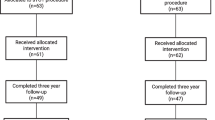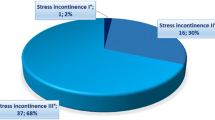Abstract
Purpose
To determine the success rate of transobturator adjustable tape (TOA, Agency for Medical Innovations, A.M.I., Austria) in stress urinary incontinent patients with maximal urethral closure pressure (MUCP) ≤20 cm H2O compared to those with MUCP >20 cm H2O.
Materials and methods
In this retrospective study, all female patients with a diagnosis of stress urinary incontinence underwent TOA, from September 2005 to August 2007. All patients had preoperative multichannel urodynamic tests (cystometry, urethral profile and uroflowmetry). During September 2008, patients were contacted by telephone and the validated short forms of the Urogenital Distress Inventory (UDI-6) questionnaire and the Incontinence Impact Questionnaire (IIQ-7) were administered.
Results
The chart review identified 146 patients (125 with MUCP >20 cm H2O and 21 with MUCP ≤20 cm H2O) who had undergone TOA and who met the inclusion criteria. Of these, 121 patients (82.9%) were contacted by telephone. Results showed a very good quality of life (score 0–7 in the IIQ-7) in 95.9% of patients. Only two (1.6%) patients had persistent significant urine leakage related to physical activity. In the MUCP ≤20 cm H2O group, 90% of patients could be considered as being very satisfied, with a very good quality of life.
Conclusion
With the TOA procedure, the obturator route could be used to treat patients with urinary incontinence and also with low MUCP.


Similar content being viewed by others
References
McGuire EJ, Fitzpatrick CC, Wan J, Bloom D, Ritchey M, Gormeley EA (1993) Clinical assessment of urethral sphincter function. J Urol 150:1452–1454
Haab F, Zimmern PE, Leach GE (1996) Female stress urinary incontinence due to intrinsic sphincteric deficiency: recognition and management. J Urol 156:3–17
Agency for Health Care Policy and Research (1992) Urinary incontinence Guidelines Panel. Urinary incontinence in adults. Clinical practice guidelines. Agency for Health Care Policy and Research, Public Health and Human Services, Rockville, MD, AHCPR publication 92–0038
Horbach NS, Ostergard DR (1994) Predicting intrinsic urethral sphincter dysfunction in women with stress incontinence. Obstet Gynecol 84:188–192
Swift SE, Ostergard DR (1995) A comparison of stress-leak point pressure and maximal urethral closure pressure in patients with stress incontinence. Obstet Gynecol 85:704–708
McGuire EJ (1981) Urodynamic findings in patients after failure of stress incontinence operation. Prog Clin Biol Res 78:351–353
Hilton P, Stanton SL (1983) Urethral pressure measurement by microtransducer: the results in symptom-free women and those with genuine stress incontinence. Br J Obstet Gynaecol 90:919–933
Romero MJ, Ortiz GM, Prieto CL, López LC, Quílez FJM, Rodríguez FE, Pacheco BJJ, TVA and TOA (2006) New adjustable mesh for the treatment of female stress incontinence. Preliminary results. Actas Urol Esp 30(2):186–194
Uebersax J, Wyman J, Shumaker S, for the Continence Program for Women Research Group et al (1995) Short forms to assess life quality and symptom distress for urinary incontinence. Neurourol Urodyn 14:131–139
Sand PK, Bowen LW, Panganiban R, Ostergard DR (1987) The low pressure urethra as a factor in failed retropubic urethropexy. Obstet Gynecol 69:399–402
Blaivas JG, Jacobs BZ (1991) Pubo-vaginal sling for the treatment of complicated stress urinary incontinence. J Urol 145:1214–1218
McGuire EJ, Bennett CJ, Konnak JA, Sonda LP, Savastano JA (1987) Experience with pubovaginal slings for urinary incontinence at the University of Michigan. J Urol 138:525–526
Rezapour M, Falconer C, Ulmsten U (2001) Tension-free vaginal tape (TVT) in stress incontinent women with intrinsic sphincter deficiency (ISD). A long-term follow-up. Int Urogynecol J 2:S12–S14
Delorme E (2001) Trans-obturator urethral suspension: mini-invasive procedure in the treatment of stress urinary incontinence in women. Prog Urol 11(6):1306–1313
Shindel AW, Klutke CG (2005) Urethral slings placed by the transobturator approach: evolution in the technique and review of the literature. Curr Urol Rep 6(5):385–392
Spinosa JP, Dubuis PY (2005) Suburethral sling inserted by the transobturator route in the treatment of female stress urinary incontinence: preliminary results in 117 cases. Eur J Obstet Gynecol Reprod Biol 123(2):212–217
O’Connell HE, McGuire EJ, Usui A, Gudziak M (1995) Pubo-vaginal slings in 1994. J Urol 153:525A
Lemack GE, Zimmern PE (1999) Predictability of urodynamic findings based on the Urogenital Distress Inventory-6 questionnaire. Urology 54:461–466
Blanc E, Hermieu JF, Ravery V, Moulinier F, Delmas V, Boccon-Gibod L (1999) Interet de l’utilisation d’un questionnaire dans l’evaluation de la chirurgie de l’incontinence. Prog Urol 9:88–93
Moran PA, Ward KL, Johnson D, Smirni WE, Hilton P, Bibby J (2000) Tension-free vaginal tape for primary genuine stress incontinence. Br J Urol 86:39–42
Segal JL, Vassallo BJ, Kleeman SD, Hungler M, Karram MM (2006) The efficacy of the tension-free vaginal tape in the treatment of five subtypes of stress urinary incontinence. Int Urogynecol J Pelvic Floor Dysfunct 17(2):120–124
Ghezzi F, Serati M, Cromi A, Uccella S, Salvatore S, Triacca P, Bolis P (2005) Tension-free vaginal tape for the treatment of urodynamic stress incontinence with intrinsic sphincter deficiency. Int Urogynecol J Pelvic Floor Dysfunct 7:1–5
Barry C, Naidu A, Lim Y, Corsitaans A, Muller R, Rane A (2006) Does the Monarc transobturator suburethral sling cause post-operative voiding dysfunction? A prospective study. Int Urogynecol J Pelvic Floor Dysfunct 30(1):4
Author information
Authors and Affiliations
Corresponding author
Rights and permissions
About this article
Cite this article
Costantini, S., Nadalini, C., Esposito, F. et al. Transobturator adjustable tape (TOA) in female stress urinary incontinence associated with low maximal urethral closure pressure. Arch Gynecol Obstet 282, 277–284 (2010). https://doi.org/10.1007/s00404-009-1257-z
Received:
Accepted:
Published:
Issue Date:
DOI: https://doi.org/10.1007/s00404-009-1257-z




